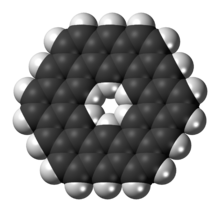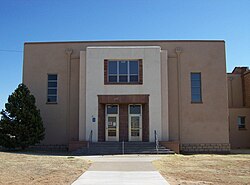케쿨렌
Kekulene | |
 | |
| 이름 | |
|---|---|
| 선호 IUPAC 이름 15,23:16,22-Di(메테노)나프토[2,3-a]테트라페노[3,2-o]펜타페네 | |
| 기타 이름 [12]–코로나펜, [12]Circulene | |
| 식별자 | |
3D 모델(JSmol) | |
| 체비 | |
| 켐스파이더 | |
펍켐 CID | |
CompTox 대시보드 (EPA) | |
| |
| |
| 특성. | |
| C48H24 | |
| 어금질량 | 600.1987 g·190−1 |
달리 명시된 경우를 제외하고, 표준 상태(25°C [77°F], 100 kPa)의 재료에 대한 데이터가 제공된다. | |
| Infobox 참조 자료 | |
케쿨렌(Kekulene)은 다순환 방향족 탄화수소와 화학 공식 CH를4824 가진 순환탄소다. 1978년에 처음 합성되었으며,[1] 벤젠 분자 구조의 발견자인 아우구스트 케쿨레(August Kekulé)를 기리기 위해 명명되었다.
지오메트리 및 전자 구조물
분자 내의 π 결합의 성질은 몇 가지 뚜렷하게 다른 배열들이 가능했기 때문에 오랫동안 논의되었다. 두 가장 중요한 제안은"Clar"구성, 6benzene-like( 향기로운 6π-electron)링non-aromatic 고리에 연결하는 채권과 비닐 그룹에 의해 연결로 구성되어 있고, 그"Kékule"구성, 두 동심 방향족 고리(18π-electron는 내부, 30π-electron 외부의)요골 단일 결합에 의해 연결되어 구성되어 있다.[2][3][4][5][6][7][8]
- 제안된 전자 구성
1978년에 처음 보고된 이 화합물의 합성은 전자 구조의 실험적인 결정을 가능하게 했다.[4] 1970년대 후반 H-NMR은 벤젠 고리의[4] 증거를 제공했고 X선 분석 결과 이 구조물은 방향족과 비자동적 고리가 교대로 [2]존재하며 둘 다 케쿨레 구성과 일치한다고 판단하였다. 2019년에는 탄소-탄소 결합 길이와 결합 주문을 측정하기 위해 단일 분자 원자력 현미경을 사용하여 비-자율 연결과 교대로 벤젠 유사 고리로 구성된 구성이 결정되었다.[9] 이 구성은 디스조인트 방향족 π섹스세트가 가장 많기 때문에 클라크의 규칙과 일치한다.
구조 전체가 본질적으로 평면이며, 6배보다는 3배 대칭에 불과하다. 고리 중앙에 있는 탄소-수소 결합은 수소 원자 사이의 장력 장애를 피하기 위해 평면에서 약간 교대로 기울어져 있다.[9]
참조
- ^ Staab, Heinz A.; Diederich, François (October 1983). "Cycloarenes, a New Class of Aromatic Compounds, I. Synthesis of Kekulene". Chemische Berichte. 116 (10): 3487–3503. doi:10.1002/cber.19831161021.
- ^ a b Krieger, Claus; Diederich, Francois; Schweitzer, Dieter; Staab, Heinz A. (September 1979). "Molecular Structure and Spectroscopic Properties of Kekulene". Angewandte Chemie International Edition in English. 18 (9): 699–701. doi:10.1002/anie.197906991.
- ^ Aihara, Junichi (January 1992). "Is superaromaticity a fact or an artifact? The kekulene problem". Journal of the American Chemical Society. 114 (3): 865–868. doi:10.1021/ja00029a009.
- ^ a b c Diederich, François; Staab, Heinz A. (May 1978). "Benzenoidversus Annulenoid Aromaticity: Synthesis and Properties of Kekulene". Angewandte Chemie International Edition in English. 17 (5): 372–374. doi:10.1002/anie.197803721.
- ^ Jiao, Haijun; Schleyer, Paul von Ragué (1 November 1996). "Is Kekulene Really Superaromatic?". Angewandte Chemie International Edition in English. 35 (20): 2383–2386. doi:10.1002/anie.199623831.
- ^ Schweitzer, D.; Hausser, K.H.; Vogler, H.; Diederich, F.; Staab, H.A. (11 August 2006). "Electronic properties of kekulene". Molecular Physics. 46 (5): 1141–1153. doi:10.1080/00268978200101861.
- ^ Staab, Heinz A.; Diederich, FrançOis; Krieger, Claus; Schweitzer, Dieter (October 1983). "Cycloarenes, a New Class of Aromatic Compounds, II. Molecular Structure and Spectroscopic Properties of Kekulene". Chemische Berichte. 116 (10): 3504–3512. doi:10.1002/cber.19831161022.
- ^ Zhou, Zhongxiang (February 1995). "Are kekulene, coronene, and corannulene tetraanion superaromatic? Theoretical examination using hardness indices". Journal of Physical Organic Chemistry. 8 (2): 103–107. doi:10.1002/poc.610080209.
- ^ a b Pozo, Iago; Majzik, Zsolt; Pavliček, Niko; Melle-Franco, Manuel; Guitián, Enrique; Peña, Diego; Gross, Leo; Pérez, Dolores (17 September 2019). "Revisiting Kekulene: Synthesis and Single-Molecule Imaging". Journal of the American Chemical Society. 141 (39): 15488–15493. doi:10.1021/jacs.9b07926. PMC 6786662. PMID 31525873.




